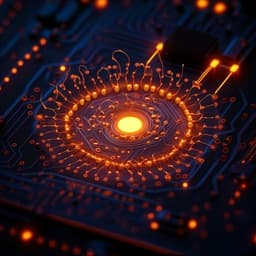
Physics
Giant voltage-controlled modulation of spin Hall nano-oscillator damping
H. Fulara, M. Zahedinejad, et al.
Discover the breakthrough in Spin Hall nano-oscillators (SHNOs) that enables unprecedented electrically gated control over microwave signal generation. This research, conducted by a team including Himanshu Fulara, Mohammad Zahedinejad, and others, showcases a remarkable 42% damping variation through voltage-dependent magnetic anisotropy, paving the way for energy-efficient individual SHNO tuning in neuromorphic computing arrays.
~3 min • Beginner • English
Introduction
The study addresses the challenge of individual frequency and on/off control of spin Hall nano-oscillators (SHNOs) within large chains and two-dimensional arrays for neuromorphic computing. Prior demonstrations of coupled spin-torque nano-oscillators used current control, which is inefficient and hard to scale. SHNOs offer energy-efficient operation with robust mutual synchronization, but individual control has been lacking. The hypothesis is that voltage-controlled magnetic anisotropy (VCMA) in W/CoFeB/MgO nanoconstriction SHNOs can tune both frequency and threshold current by modifying perpendicular magnetic anisotropy (PMA) and, uniquely due to the nanoconstriction geometry, alter spin-wave mode localization and radiative losses. The purpose is to demonstrate and quantify voltage control of damping, threshold current, and frequency, enabling per-oscillator control in large SHNO networks.
Literature Review
Background includes neuromorphic computing with oscillator networks and demonstrations using coupled STNOs for vowel recognition. SHNOs have advantages such as pure spin current excitation via the spin Hall effect, easy fabrication, and CMOS compatibility, with nanoconstriction SHNOs showing robust synchronization in chains and 2D arrays up to 64 devices. Voltage control of magnetic anisotropy (VCMA) has been widely explored to reduce energy for magnetization switching (e.g., in STT-MRAM). Two main VCMA mechanisms are reported: electronic-structure-related effects (redistribution among 3d orbitals, Rashba SOC, DMI) and ionic mechanisms (voltage-driven O2− migration altering interfacial oxidation), with the latter often yielding larger PMA changes. Prior works reported VCMA values spanning tens to hundreds of fJ/Vm depending on interface engineering. The present work situates within these studies, leveraging VCMA in CoFeB/MgO to control SHNO dynamics.
Methodology
Devices: Gated nanoconstriction SHNOs based on β-W(5 nm)/(Co0.75Fe0.25)75B25(1.7 nm)/MgO(2 nm)/Al2O3(2 nm) on intrinsic high-resistivity Si. β-W provides strong spin-orbit torque; CoFeB/MgO confers interfacial PMA. Fabrication: Sputter deposition (dc for metals, rf for insulators) at room temperature; 2 nm Al2O3 cap; anneal at 300 °C for 1 h to induce PMA. Patterning into 4 × 14 μm2 mesas; nanoconstrictions defined by e-beam lithography and Ar ion beam etching using negative resist. After resist removal, 15 nm sputtered Si3N4 isolation; gate defined by Ti(2 nm)/Cu(40 nm) patterned to ~100 nm width over the constriction via e-beam lithography and IBE. Vias opened in Si3N4 by optical lithography; contacts including two SG-CPWs formed by lift-off of Cu(700 nm)/Pt(20 nm).
Microwave auto-oscillation measurements: Room temperature; sample mounted at in-plane angle φ = 22° on an out-of-plane rotatable holder in a uniform magnetic field. A Keithley 6221 sourced positive dc current via bias-T; gate voltage from a Keithley 2400. Emitted microwave signal amplified by ≥32 dB LNA and measured by a 10 Hz–40 GHz spectrum analyzer (1 MHz RBW). Devices measured up to Idc = 1.4 mA to avoid degradation; leakage current ≤5 nA at VG ≤ 2 V during auto-oscillation.
ST-FMR: Performed on a 150 nm gated nanoconstriction under similar field geometry (φ = 22°, θ = 66°). An rf current (modulated at 98.76 Hz) at fixed frequencies 4–12 GHz with input power −18 dBm applied via bias-T to generate spin-orbit torques and Oersted fields. The magnetization precession modulates device resistance (magnetoresistance), producing a dc mixing voltage detected by lock-in. Field sweeps from 550 to 0 mT at fixed rf frequency; resonance fitted with a sum of symmetric and antisymmetric Lorentzians to extract resonance field and linewidth (HWHM). Due to gate breakdown risk at higher positive voltages during long sweeps, ST-FMR was limited to VG ≤ +1 V. Additional ST-FMR with small dc bias probed current-dependence of linewidth at 6 and 12 GHz.
Micromagnetic simulations: Performed with MuMax3 (GPU-accelerated). Geometry of 150 nm-width nanoconstriction from CAD, discretized into 1024 × 1024 × 1 cells (4 × 4 × 1.7 nm3). Current distribution modeled in COMSOL. Excitation via ~10 ps Gaussian pulse of spin-transfer torque; after pre-relaxation to linear regime, residual oscillations (averaged under gate) fitted to m = A sin(2π f t + φ) exp(−2π Δf t) to extract f (FMR frequency) and Δf (decay rate); damping α derived. Parameters: μ0 Hext = 0.4 T, Ms = 1050 kA/m, intrinsic α = 0.009, Aex = 19 pJ/m. PMA K(VG=0) = 645 kJ/m3 (tCoFeB K = 1096.5 μJ/m2); VCMA −2.5 kJ/m3 per Volt (−103.4 fJ/Vm per area per electric field).
Key Findings
- Applying gate voltage to W/CoFeB/MgO nanoconstriction SHNOs yields large, linear tunability of key dynamical properties.
- Threshold current I_th modulation: 22% total change for VG = ±2 V (slope ≈ 5.5%/V). I_th extracted from linear fits of 1/P vs Idc well above threshold.
- Frequency tunability: ~50 MHz total shift over ±2 V (slope ≈ 12 MHz/V) at Idc = 1.2 mA under μ0 H = 0.4 T, with φ = 22°, θ = 60°.
- Effective damping modulation: ST-FMR linewidth analysis across 4–12 GHz shows a giant 42% change in effective damping α over ΔVG = 4 V, linear with slope ≈ 0.002 per Volt (γ/2π = 29.1 GHz/T used in fits). Linewidth vs frequency fitted to ΔH = ΔH0 + 2παξ/(γ μ0).
- Effective magnetization Meff: Kittel fits show a linear dependence on VG with ~14% overall change in μ0 Meff over 4 V, translating to a minor (<1%) tunability of interfacial PMA (using μ0 Ms = 1.3 T), consistent with a VCMA magnitude ~103.4 fJ/Vm.
- Mechanism: Micromagnetic simulations reveal that VG tunes PMA and thereby the localization of the nanoconstriction mode and its coupling to propagating spin waves. Negative VG increases PMA, delocalizing the mode and enhancing radiative (emission) losses, increasing total damping; positive VG localizes the mode in the constriction, reducing radiation losses and effective damping. Simulated damping vs VG agrees with experiment.
- Current-dependence of linewidth slopes at 6 and 12 GHz depend on VG, indicating VG-controlled mode volume/overlap with current; stronger localization at +1 V, weaker at −3 V, consistent with simulations.
Discussion
The findings show two largely independent voltage-controlled effects: (1) a strong modulation of effective damping via changes in mode localization and radiation losses induced by modest VCMA-driven PMA tuning; and (2) a moderate change in effective magnetization Meff that shifts the FMR and auto-oscillation frequencies according to the Kittel relation for oblique fields. The observed VCMA is consistent with electronic band-structure mechanisms at the CoFeB/MgO interface (redistribution among 3d orbitals, Rashba SOC, and DMI modulation). The ionic mechanism (voltage-driven O2− migration) can in principle yield much larger PMA changes, but the present devices exhibit minor PMA tunability and an estimated VCMA ~103.4 fJ/Vm, suggesting the dominance of electronic effects. The strong damping tunability directly enables per-oscillator threshold control: with a global drive current across an SHNO array, applying voltage to selected nodes can turn oscillators on or off, while preserving mutual synchronization—useful for neuromorphic and oscillator-network computing. The demonstrated ~50 MHz frequency tuning is sufficient to adjust synchronization maps used in prior neuromorphic tasks (e.g., vowel recognition), potentially closing ~50 MHz gaps in array synchronization spectra. Overall, voltage gating adds energy-efficient, scalable, individual control to nanoconstriction SHNOs without additional antennas or interconnects, maintaining advantages such as high operating frequency, wide locking range, and scalability to dense arrays.
Conclusion
This work demonstrates giant, linear, voltage-controlled modulation of effective damping (42% over 4 V), substantial threshold current tunability (22% over ±2 V), and robust frequency tuning (~50 MHz; 12 MHz/V) in gated W/CoFeB/MgO nanoconstriction SHNOs. The mechanism arises from modest VCMA that shifts mode frequency and, crucially, alters mode localization and radiative coupling to extended spin waves, thereby tuning total damping. These capabilities enable energy-efficient, individual on/off and frequency control of oscillators within synchronized SHNO chains and arrays, advancing their applicability to neuromorphic computing. Future directions include: (i) interface engineering to enhance VCMA (e.g., Ir-doped Fe with CoFe termination) or employing magneto-ionic approaches for larger, potentially non-volatile PMA/damping control; (ii) device layout optimization (gate width, constriction opening angle) to tailor the ratio of core vs radiative losses; and (iii) boosting output power by integrating a magnetic tunnel junction (W/CoFeB/MgO/CoFeB) over the constriction.
Limitations
- ST-FMR measurements were limited to VG ≤ +1 V due to gate breakdown during long field sweeps at higher positive voltages, constraining the explored positive gating range.
- Auto-oscillation measurements limited Idc to ≤1.4 mA to avoid device degradation, potentially restricting full performance characterization.
- ST-FMR primarily probes the gated nanoconstriction region; results may not reflect ungated regions.
- While simulations reproduce damping modulation via mode localization, a minor intrinsic damping change under gating cannot be excluded.
- Interfacial PMA tunability observed was <1%, indicating only modest VCMA in the present stack; larger effects may require different interface engineering or ionic control.
Related Publications
Explore these studies to deepen your understanding of the subject.







